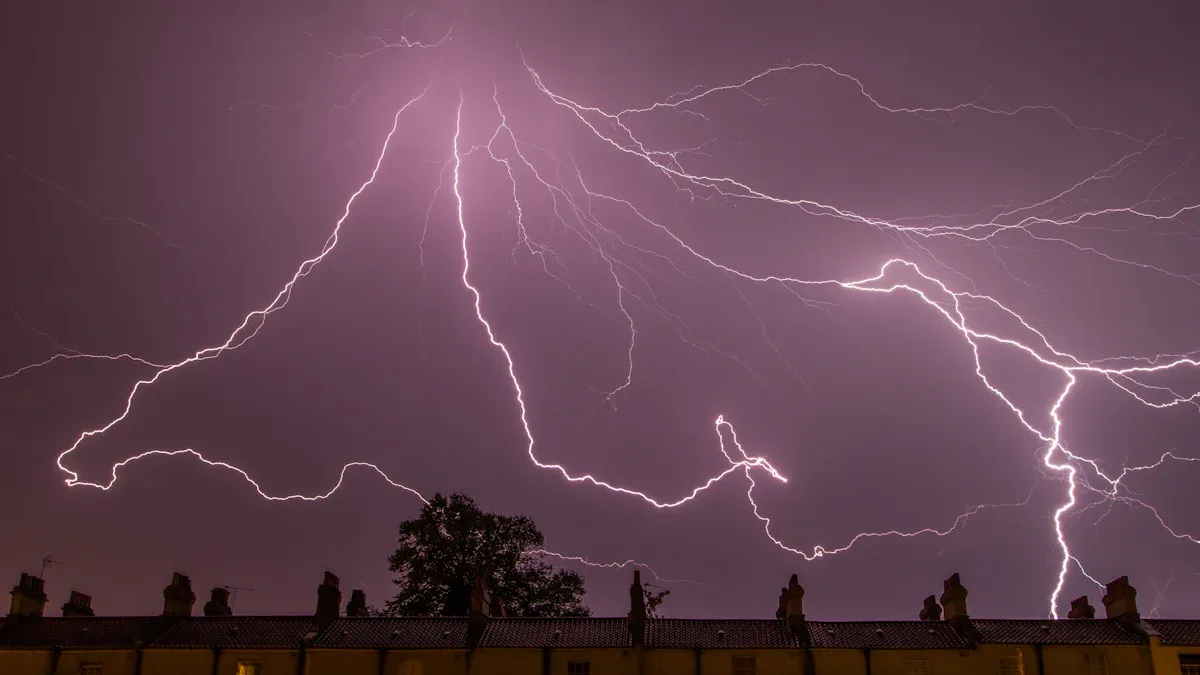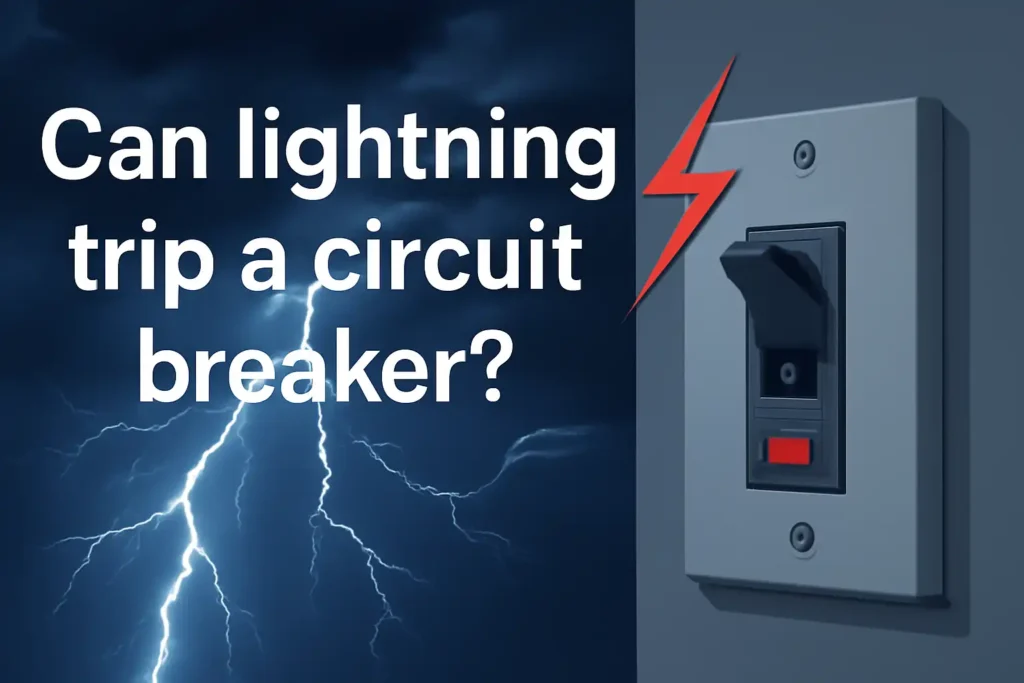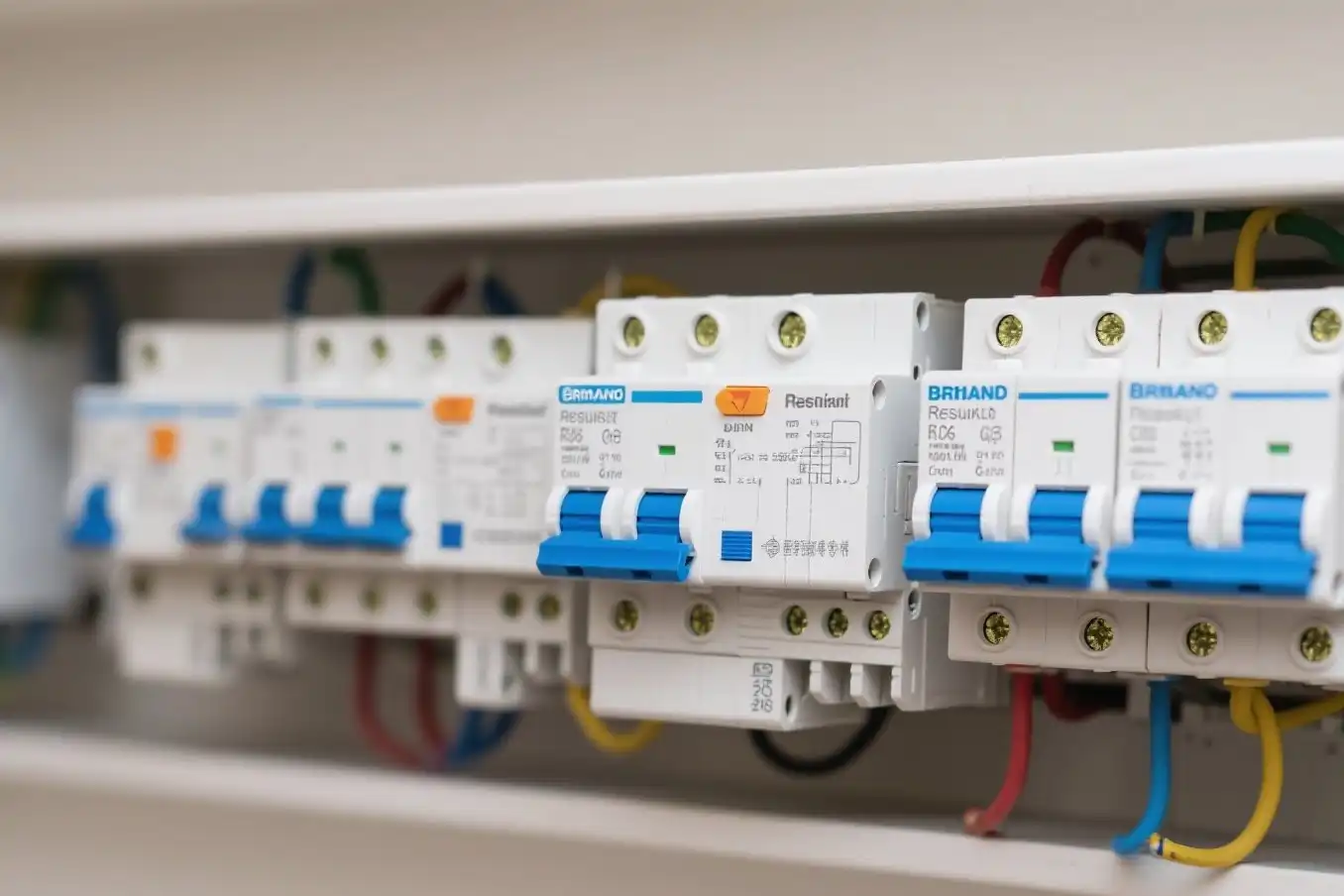Lightning can cause circuit breakers to trip due to power surges. When lightning strikes, it generates a significant amount of electrical energy. The initial strike can produce currents up to 20kA, while subsequent strikes can reach 15kA. These surges occur in mere milliseconds and can overwhelm home electrical systems. Circuit breakers are designed to keep your home safe by interrupting the electricity flow during such events. However, extremely strong surges, like those from lightning, can be too powerful for them to handle. Some advanced devices, such as Type SI RCDs, can manage up to 5kA of lightning current. Nevertheless, not all systems are equipped with this level of protection. Understanding this risk enables you to better safeguard your home.
Key Takeaways
- Lightning can trip circuit breakers because of strong electrical surges. Knowing this helps you keep your home safer.
- Surge protectors are important to protect devices from lightning. Install whole-house surge protectors for the best safety.
- Checking your electrical system often can stop lightning damage. Plan inspections to find weak areas and stay safe.
- After lightning strikes, look for damage like burn marks or odd smells. If you see anything strange, call an electrician right away.
- If a breaker trips in a storm, turn off all devices first. Reset it carefully. If it trips again, get professional help to fix the problem.
Lightning Can Cause Circuit Breakers to Trip
How lightning generates power surges
Lightning releases a huge amount of energy when it strikes. A single bolt can carry 300 million volts and 30,000 amps. For comparison, a household outlet only provides 120 volts. Rarely, lightning currents can reach nearly 400 kA, which is far beyond what most circuit breakers can handle.
Lightning creates power surges in two ways: direct strikes and induced surges. A direct strike happens when lightning hits a building or power line. This sends a large current through the system. Induced surges occur when lightning strikes nearby. This creates electric and magnetic fields that affect nearby circuits, causing a sudden voltage spike.
| Mechanism | Description |
|---|---|
| Induced Surges | Caused by nearby lightning creating electric and magnetic fields. |
| Circuit Parameters | Factors like distance affect how strong the surge is. |
| Simulation Method | Special tools, like FDTD, model lightning’s effects on systems. |
These surges travel through power lines into your home’s electrical system. If not controlled, they can cause serious damage. Knowing how lightning creates surges helps you protect your home better.
The role of circuit breakers during electrical disturbances
Circuit breakers protect your home from electrical problems. They watch the flow of electricity and shut off power during overloads or surges. This helps prevent damage to devices and lowers the chance of electrical fires.
Lightning can trip circuit breakers because its energy is often too strong. Lightning surges can reach up to a billion volts, far more than standard breakers can handle. Studies show that 50% of lightning strikes produce at least 18,000 amps, with some going over 140 kA. These levels can overwhelm even advanced breakers, causing them to trip or fail.
“Breaker failure protection is key to keeping systems stable during big electrical events,” says research on circuit breaker performance.
While circuit breakers handle normal electrical issues well, they may fail during strong lightning strikes. This shows why extra protection, like surge protectors, is important for keeping your electrical system safe.
How Circuit Breakers Protect Electrical Systems
How circuit breakers work
Circuit breakers guard your home’s electrical system from harm. They watch the electricity flow and stop it if there’s a problem. Inside, two key parts handle different electrical issues.
- Overload Protection: Too much current makes a metal strip heat up. The heat bends the strip, causing the breaker to trip and stop power.
- Short Circuit Protection: A sudden current surge creates a magnetic field. This field moves a lever, cutting power in milliseconds.
These parts work together to keep your home safe from damage. Studies show circuit breakers are vital for stable power systems. Checking them often ensures they work properly and protect your home.
Why circuit breakers trip during surges or overloads
Circuit breakers trip to stop damage and prevent fires. Overloads happen when too many devices use power at once. For example, plugging in many big appliances can cause an overload.
Short circuits happen when electricity takes the wrong path. This creates a big current spike, making the breaker trip. Broken machines can also draw extra power, causing surges that trip breakers.
Lightning can trip breakers by sending huge surges through your system. These surges are too strong for most breakers, so they shut off power. While breakers handle normal problems well, they may fail during lightning strikes. Using surge protectors adds extra safety for your electronics.
Effects of Lightning on Electrical Systems
Voltage spikes and their impact
Lightning creates strong voltage spikes that can harm your home’s electricity. These spikes happen when lightning’s energy moves through power lines or the ground. The sudden increase in voltage can damage devices and even start fires.
Voltage spikes depend on things like ground type and rod length. For example:
- Ground rods act like resistors and capacitors during lightning strikes.
- The highest voltage depends on the surge shape and ground type.
- Research shows peak voltages may be lower with resistive ground rods.
One study tracked 64 lightning voltages on a 2.7 km test line. About 67% were one-directional, while the rest switched directions. This shows how unpredictable lightning surges are, making protection very important.
Scientists have created ways to study these spikes better. For example, Darveniza updated Rusck’s formula to include soil type. Others used probability methods to study lightning effects. These studies show why preparing for voltage spikes is crucial.
Signs of lightning-related electrical damage
Lightning can leave noticeable damage in your electrical system. Spotting these signs early helps fix problems quickly. Common signs include:
- Burn or scorch marks on outlets, wires, or devices.
- A strong burnt smell near electrical items.
- Lights flickering or devices suddenly stopping.
- Circuit breakers tripping and not resetting.
In serious cases, lightning can cause injuries. For example:
| Type of Injury | Description |
|---|---|
| Nervous system damage | Harm to nerves from an electrical shock. |
| Eardrum damage | Eardrums harmed by the shockwave of lightning. |
| Breathing problems | Breathing stops due to electrical shock, causing suffocation. |
Lightning can trip circuit breakers to stop further harm. If you see these signs, check your system and call an expert to keep your home safe.
Preventing Circuit Breaker Trips from Lightning

Installing Surge Protectors
Surge protectors are great tools to guard your home. They block extra electricity from reaching your devices. Without them, lightning can trip circuit breakers and harm your home.
There are two main types of surge protectors:
- Point-of-use surge protectors: Small devices that plug into outlets. They protect items like TVs, computers, or fridges.
- Whole-house surge protectors: Installed at the electrical panel, they protect the entire home.
If you live in a stormy area, these are very useful. Power surges cost U.S. businesses over $80 billion yearly. Surge protectors help avoid expensive repairs and keep your home safe.
Tip: Pick surge protectors with high joule ratings for stronger protection.
Benefits of Whole-House Surge Protection
Whole-house surge protectors give full coverage for your home. Unlike smaller devices, they stop surges at the source. This keeps the surge from spreading through your wiring.
Here’s how much damage you can avoid with whole-house surge protection:
| Damage Type | Cost Range ($) |
|---|---|
| Replacing Damaged Appliances and Electronics | $50 to $3,000+ |
| Electrical System Repair | $200 to $2,000+ |
| Insurance Deductibles | $500 to $2,500+ |
| Fire Damage | $2,000 to $100,000+ |
| Loss of Data | $200 to $10,000+ |
| Home Electronics and Automation System Repair | $100 to $5,000+ |
| Loss of Business Revenue | $500 to $10,000+ per day |
| Preventative Costs (Surge Protectors) | $100 to $1,500+ |
Surge-related damage can cost over $15,000 on average. For instance, a lightning strike in Massachusetts caused $11,000 in damage to one home. Whole-house surge protectors can stop such losses and save you money.
Note: Whole-house surge protectors may cost more upfront but save you from bigger repair bills later.
Regular Electrical System Maintenance
Keeping your electrical system in good shape is important. Regular checks can find weak spots, like old wires or broken parts, that might fail during a surge.
Here’s a suggested maintenance schedule:
| Maintenance Type | Frequency |
|---|---|
| Visual Inspection | Twice yearly and after major storms |
| Complete Verification (Protection I & II) | Every two years |
| Complete Verification (Protection III & IV) | Every four years |
| Complete Verification of Critical Systems | Annually for all protection levels |
| Professional Assessments | Every 3-5 years |
| Earth Resistance Testing | Annually (below 10 ohms) |
Following this schedule keeps your system strong against lightning surges. Electricians can test your surge protectors to ensure they work well. Skipping maintenance can lead to circuit breaker trips and costly damage.
Tip: After big storms, check your system for damage, even if no breakers tripped.
Steps to Take After a Lightning-Induced Circuit Breaker Trip
Safely Resetting a Tripped Breaker
Resetting a breaker after lightning needs careful steps. First, turn off and unplug all devices on the circuit. This stops more damage if the breaker trips again. Find the breaker panel and locate the switch in the “off” or middle position. Push it fully to “off,” then flip it back to “on.”
Tip: If the breaker trips again right away, stop trying to reset it. This might mean a bigger problem that needs an expert.
Lightning can harm the inside parts of breakers, making them unsafe. Check for burn marks or a burnt smell before resetting. If you see anything odd, stay safe and call an electrician.
When to Seek Professional Help
Some problems need an expert to keep your home safe. Call an electrician if:
- The breaker keeps tripping or won’t stay on.
- You smell burning, hear buzzing, or see sparks near the breaker.
- Outlets or switches look burned or feel very hot.
Breakers that trip often may mean serious electrical issues. If unplugging devices and resetting doesn’t fix it, call a professional.
Lightning can secretly damage wires or appliances, which only experts can find. Fixing these problems quickly keeps your home safe and up to code.
Inspecting Appliances and Wiring for Damage
After lightning, check appliances and wiring for damage. Look for burn marks, melted wires, or strange smells near outlets. Flickering lights or devices that won’t turn on could also mean damage.
Follow these tips for a detailed check:
| Inspection Criteria | Description |
|---|---|
| Air Terminal Layout | Make sure there are two paths to the ground. |
| Terminal Height | Tips should stick out at least 10 inches above the roof. |
| Grounding | Ground rods must be 8 feet long and buried at least 10 feet deep. |
| Component Compatibility | Don’t attach copper parts to aluminum surfaces. |
| Cable Bend Radius | Keep cable bends at least 8 inches wide. |
These checks help find weak spots in your system. If you see major damage, don’t use the circuits or devices until an expert checks them. These steps reduce risks and keep your home safe after lightning.
Lightning might trip circuit breakers, but they protect your home. Reduce damage risks by using surge protectors and checking your system often. If a breaker trips in a storm, reset it safely. Look for damage signs like burn marks or strange smells. If unsure, ask an expert to stay safe. These steps help protect your system and lower lightning problems.
ONESTOP Electrical provides customized solutions for you. Click to view the product series and find the right choice for you.
FAQ
Why does lightning cause power surges?
Lightning creates a lot of electrical energy. When it hits, this energy moves through power lines. It causes sudden voltage spikes that can harm your home’s system. These spikes may damage devices and trip circuit breakers.
Why do circuit breakers trip during storms?
Circuit breakers protect your home by stopping power flow. Lightning surges send too much current through the system. The breaker notices this and shuts off power to avoid fires or damage.
Why are surge protectors important during lightning storms?
Surge protectors stop extra voltage from harming your devices. They act like shields, absorbing or redirecting lightning surges. This keeps your appliances safe and lowers the chance of breaker trips.
Why should you inspect your electrical system after a storm?
Lightning can harm wires, outlets, and devices. Checking your system helps find burn marks, melted parts, or odd smells. Fixing these problems early keeps your home safe and prevents bigger issues.
Why is whole-house surge protection better than individual protectors?
Whole-house surge protectors guard your entire system. They block surges at the main panel, protecting all devices. Individual protectors only shield specific items, leaving other parts unprotected.
The following information may be of interest to you
Type 2 AC surge protection device
How to Replace a Surge Protector Safely and Efficiently
What Happens When Cold Weather Trips Circuit Breakers
Can you place the three pole circuit breaker on the single-phase panel




